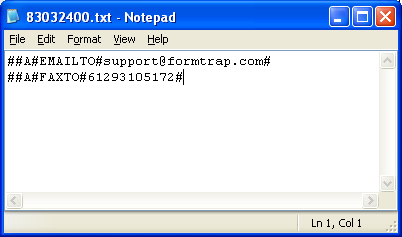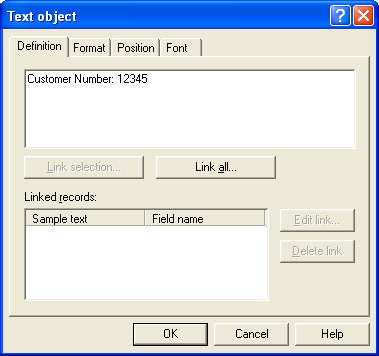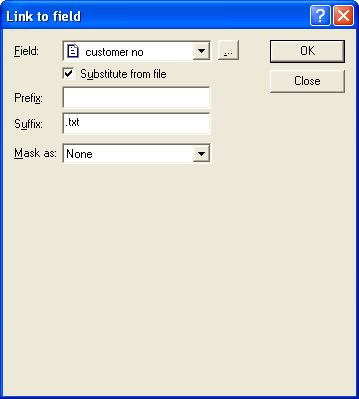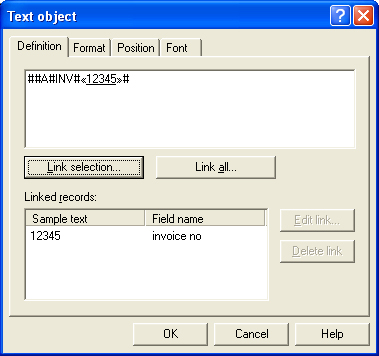|
|
|
| Step 3 - Creating
Associated File fields in FTDesign |
|
To generate an Associated File, you must
create Associated File field(s) on the form(s). Associated file
fields are created in the same way as normal text fields but
do not print on the final output from FormTrap. After the new
fields have been added, the form must be built into an ASC file
and reloaded into FTSpooler.
More information on Loading and Updating FormTrap Forms
Instructions below show three different ways in which to
design the Associated File field for different end results.
Examples include obtaining a delivery email address from the
input data, using a substitution file to obtain field values and
using multiple Associated File fields on the same form.
|
|
Example 1: Capturing the Email Address from Input Data |
If a client's email address appears in the input data
file, it is then possible to use this data to email the
form
to that email address. An Associated File field
is created which includes email address
from the data and masks it with the Associated File
command. At run time an Associated File entry is
created, which directs FTSpooler to email to
that email address. Note that you need to split the file
into individual documents first.To Create an Associated
File Field in FTDesign:
|
|
|
Top
|
|
Example 2: Using Substitution |
Associated Files
can be used in conjunction with substitution to provide
versatile document management. Associated file
substitution allows each client to have a unique
configuration for delivery. Each client's delivery
options are stored in a file on the FTSpooler server. At
runtime FormTrap accesses this file and delivers the
formatted document to each client using the appropriate
delivery method.
A substitution file needs to be created for each
client. This
file contains the delivery options for a client in
the Associated File command format. FormTrap will access
this file at runtime with the file and the Associated File commands
will be used to determine the delivery method for this
particular client.
To create a substitution file::
- Open Notepad. (You may use other text
editor such as Word)
- Type in the Associated File commands in the
Notepad. In our example, the formatted statement
will be emailed to
support@formtrap.com or (second example) faxed to 61293105172.

- Save the file into the Substitution Directory
which is by default located in
C:\Documents
and Settings\USERPROFILE\Application Data\TCGIS\ FTDataRoot\ DATAFOLDER\FTDATA\FTSUBST\
where DATAFOLDER refers to the name of the data
folder.
This text file name must uniquely relate to
each client (e.g. include the customer number in
the substitution file name). We would use TCG001 as
the customer number in this example.
Variable substitution field is created in
FTDesign which uses the customer number to access the
corresponding substitution file. The
Associated File commands in the substitution file notify
FormTrap of each client's delivery requirements.
To create a variable substitution field:
- Choose Text from the Draw menu or
click the Text in tool bar.
- Click and drag diagonally to add the text frame.
- Release the mouse button and the Text
dialog box will open.
- On the Definition tab, type a sample
customer number in the Text box.

- Highlight the sample customer number and click
Link Selection button.
- The Link to field dialog box will pop up.
On the field dropdown menu. Select the customer
number field name or
click the Browse button to create a new
field.
- Check the Substitute from file checkbox
and specify the substitution file type in suffix
box, which is
.txt in our example. Use Prefix if the
customer name is prefixed, for example "FAX" if the
file name is FAXcccc.txt.

- Click OK.

|
|
|
Top
|
|
Example 3: Using Multiple Associated Fields |
The Associated file may contain one or many fields, all
of which can be post-processed accordingly. Furthermore,
multiple values can be concatenated to provide more
meaningful information. In the following example,
Associated File entries for the email address, email
subject and invoice number are created. The Associated
File entry for the invoice number is created so it can
then be referenced in the email subject line.
To add the email address Associated File field:
The invoice number Associated File Field is
created:
- Choose Text from the Draw menu or
click the Text in tool bar.
- Click and drag diagonally to add the text frame.
- Release the mouse button and the Text
dialog box will open.
- On the Definition tab, type the
associated file command and a sample invoice number
in the Text box.
##A#INV#12345#

- Highlight the sample invoice number and click
Link Selection button.
- the Link to field dialog box will pop up.
On the field dropdown menu. select a field name or
click the Browse button to create a new
field.

- Click OK.

The email subject line Associated File field
is created. This Associated File field will also
reference the invoice number Associated file field
created previously. To reference the other field, the
Associated File field name is enclose in a square
brackets "[ ]", within the command line. For
instance,
##A#SUBJ#Your Invoice No: [INV]#
To create the field:
- Choose Text from the Draw menu or
click the Text in tool bar.
- Click and drag diagonally to add the text frame.
- Release the mouse button and the Text
dialog box will open.
- On the Definition tab, type the
Associated File command in the Text box,
which in our example is
##A#SUBJ#Your Invoice No: [INV]#.

- Click OK.
|
|
|
Top
|
|
|
|

